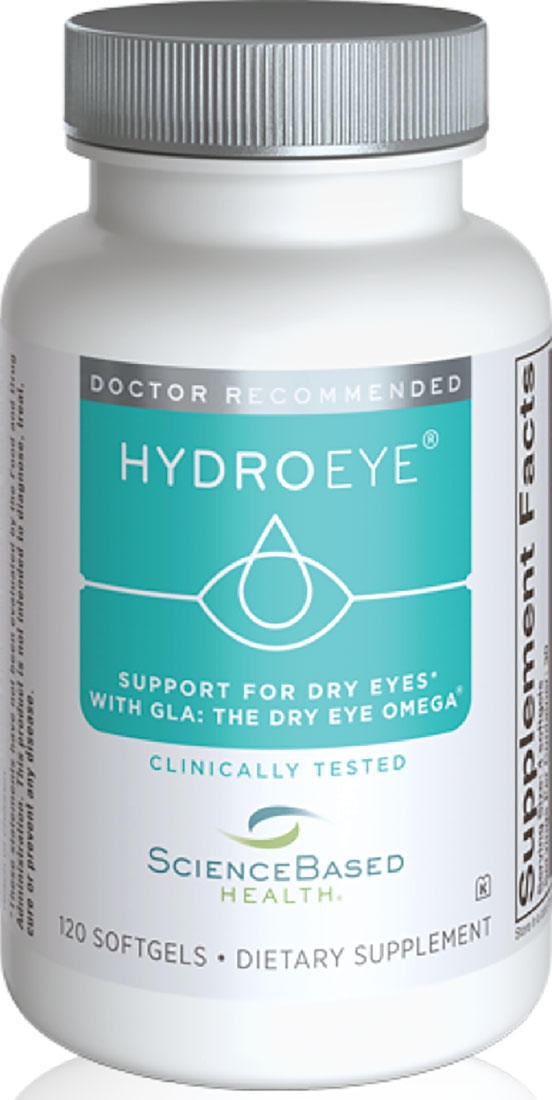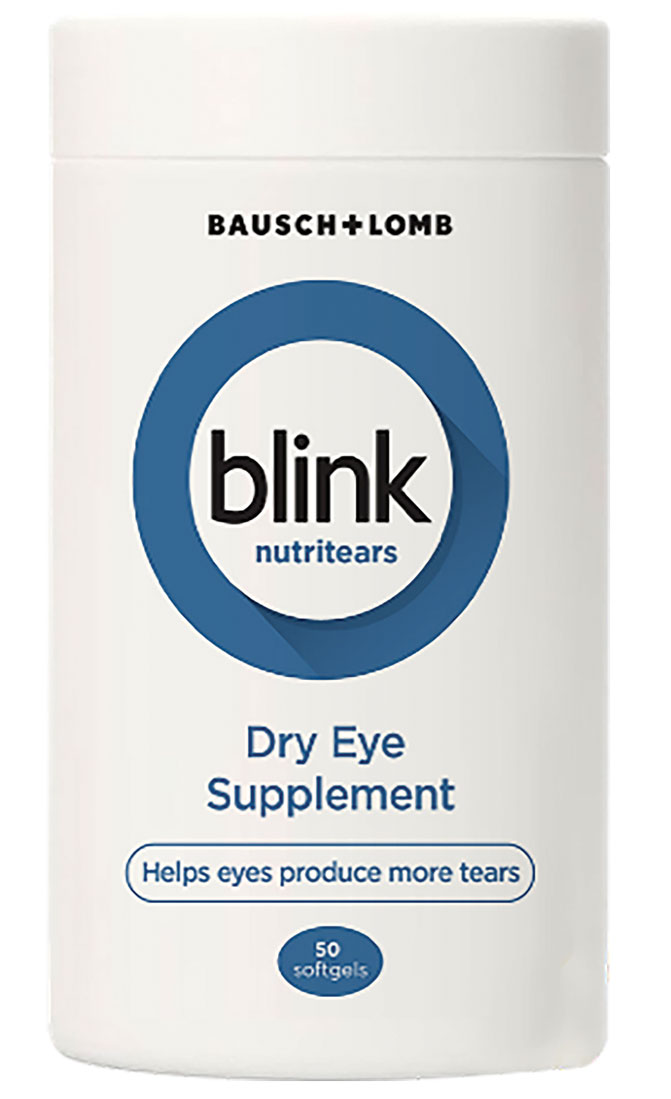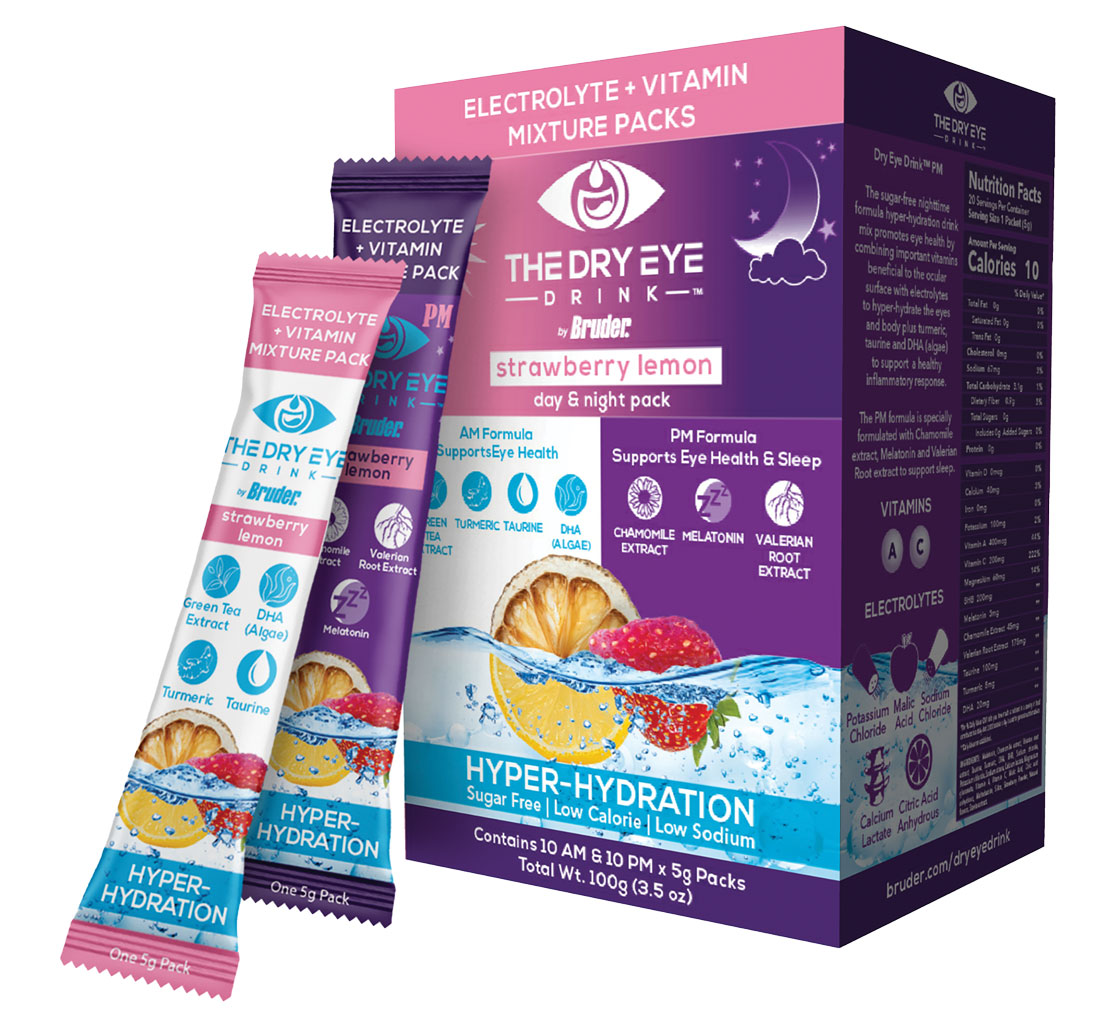 |
Dry eye is multifactorial, yet some clinicians approach management of it one-dimensionally, relying solely on traditional treatments like artificial tears and prescription meds. Others have long stood beside the belief that nutrition—encompassing diet, hydration and supplementation—also plays a vital role and should therefore be considered in recommended treatment protocol. Admittedly, those of us in this latter camp have often fought an uphill battle trying to get patients to eat healthier and drink more water. We’ve often witnessed little to no improvement in signs or symptoms when patients self-select bulk or inexpensive supplements with omega-3 on the label.
Fortunately, the supplement landscape is shifting, thanks to concerted efforts from eyecare manufacturers who have developed targeted treatments that promise results. In the process, I expect that the those of us who advocate and prescribe nutritional approaches to dry eye therapy will expand. As detailed here, evidence supporting the use of oral nutritional supplements is growing rapidly as additional bioactive compounds continue to be added to the list of ingredients being forwarded as potentially beneficial.
Mixed Reviews on Omegas
As Hamza Shah, OD, MS, detailed in the May cover story of Review of Optometry, “All Eyes on Omegas,” our go-to supplement ingredient has been challenged in recent years.1 After decades of research demonstrating beneficial effects of omegas on dry eye, the Dry Eye Assessment and Management (DREAM) study conducted by the National Institute of Health was released, leading many clinicians to abandon supplements generally based on the findings on omega-3s in this study.2-8 Although it was a robust investigation, the placebo was refined olive oil. Olive oil is primarily n-9 oleic acid, which may have anti-inflammatory properties similar to omega-3 fatty acids.9 In other words, placebo group benefits may have diluted the distinction with the treatment group. The study has also been criticized for being conducted in a real-world vs. a typical trial setting that would have controlled for factors such as diet or other treatments.
Also important to note is that use of omegas has extended beyond omega-3s and includes the successful use of gamma linolenic acid (GLA). This is a distinctive omega-6 fatty acid rarely found in significant amounts in the typical diet. It can be converted into the anti-inflammatory prostaglandin, PGE1, which helps maintain healthy tear production. Clinical research shows that GLA alleviates symptoms and reduces inflammation in individuals with dry eye, enhances tear production in those undergoing laser eye surgeries and improves both symptoms and anti-inflammatory prostaglandin levels in people with Sjögren’s syndrome.10-14
 |
|
HydroEye contains a high concentration of GLA with converting factors that help target PGE1. Photo: ScienceBased Health. Click image to enlarge. |
More to Omegas Than Meets the Eye
One nutraceutical has long been a foundation of my dry eye practice across a wide spectrum of patients and dry eye types. Validated in a clinical trial published in the journal Cornea, HydroEye (ScienceBased Health) combines a precise balance of the omega fatty acid GLA from black currant seed oil plus other omegas and nutrient cofactors.6 In that study, eye doctors and researchers found this significantly improved symptoms, dampened inflammation and maintained corneal smoothness.
The inflammatory markers examined in this study—HLA-DR and CD11c, measured with impression cytology—are markers on conjunctival dendritic cells representing key steps in the inflammatory cascade in dry eye. HLA-DR levels have been highly correlated with DEWS dry eye severity score and with signs and symptoms of moderate to severe dry eye.15,16 Impression cytology offers a higher quality of evidence, with both objective and quantifiable results.
Gamma linolenic acid, largely absent in our diet and lacking in fish or flaxseed oils, is the precursor for an anti-inflammatory eicosanoid, PGE1, which stimulates tear production and reduces ocular surface inflammation.12 This targeted action sets GLA apart from fish oil omega-3s tested in studies such as the DREAM study. In my clinic, I’ve found HydroEye to be effective for meibomian gland dysfunction, ocular rosacea, Sjögren’s and almost any dry eye with a significant inflammatory component. It’s become my go-to baseline treatment and one that my patients consistently tell me is working.
More on the Menu
The new Blink NutriTears (Bausch + Lomb) supplement contains several ingredients that can be beneficial for our dry eye patients:
• Curcumin. This turmeric-derived polyphenol is renowned for its anti-inflammatory effects.17,18 Research indicates it influences oxidative stress and cytokine pathways involved in development of eye conditions like glaucoma, age-related macular degeneration (AMD) and dry eye disease.17,18 In vitro studies reveal curcumin can reduce proinflammatory cytokines in corneal epithelial cells and act as a neuroprotectant for retinal precursor cells.
• Vitamin D3. This prohormone possesses anti-inflammatory, antioxidant and immunomodulatory qualities.19 In vitro studies show that vitamin D3 exhibits anti-inflammatory effects on the cornea by suppressing stress-induced cellular inflammation and modifying signaling to decrease proinflammatory cytokine release. In individuals with dry eye, low levels of vitamin D3 are associated with increased disease severity, reduced tear film stability and lower tear volume. Supplementation has been shown to improve the effectiveness of artificial tears and reduce disease severity in both vitamin D3-deficient and non-deficient patients.17,19-21
• Lutein and zeaxanthin. These carotenoid pigments are found exclusively in the human macula and are most well-known as dietary supplements to help prevent vision loss due to AMD; however, they are making their way into dry eye formulations as well.22 Once ingested, lutein exhibits antioxidant and anti-inflammatory effects, protecting the retina from photo-oxidative damage and reducing the production of inflammatory cytokines caused by blue light exposure.23
 |
|
The new Blink NutriTears dry eye supplement. Photo: Bausch + Lomb. Click image to enlarge. |
Drink Your Dry Eye Nutrition
What could be better than anti-inflammatory nutrients known to improve dry eye combined with hydration? Given that water makes up a significant portion of the eye, it’s clear why hydration is crucial for maintaining ocular health.24 Proper hydration supports key aspects of ocular physiology, morphology and various pathophysiological processes in the eye, and is a critical factor in the etiology and management of dry eye disease.25,26 Despite the well-documented importance of hydration, the average person’s water intake falls significantly below recommended levels. This lack of adequate hydration may contribute to a host of ocular issues, particularly in patients who suffer from dry eye disease.
Recognizing this gap in care, the Dry Eye Drink by Bruder was developed to provide a practical and effective way for patients to stay hydrated. Now with the introduction of the PM formula, which promotes better sleep, the drink offers even more tailored support for dry eye patients.
Sleep disturbances are common among individuals with dry eye, and research has established a strong connection between dry eye disease and sleep disorders, including higher rates of prevalence, incidence and severity of these conditions.27 This connection suggests that improving sleep quality may also alleviate dry eye symptoms. While direct evidence linking sleep interventions to improvements in dry eye metrics is lacking, the data strongly supports the hypothesis that better sleep could help manage the disease.
In light of this research, healthy sleep habits have increasingly been recommended as an essential part of dry eye management alongside traditional ocular hygiene practices. This was emphasized in the recently released and highly distinguished TFOS Lifestyle report, where it was stated: “A systematic review and meta-analysis including 19 articles found that, compared to controls, dry eye disease patients have poorer sleep quality, spend less time asleep, experience more sleep disturbances and may have increased prevalence, incidence and severity of sleep disorders.” The Dry Eye Drink PM’s dual focus on both sleep and hydration underscores the importance of overall body hydration in maintaining eye health. Proper hydration is believed to help the eyes function more effectively by addressing one of the root causes of dry eye: insufficient moisture in the ocular environment.
Developed by a team of optometrists and ophthalmologists, the Dry Eye Drink was formulated to provide targeted relief from dry eye symptoms. The inclusion of anti-inflammatory ingredients, along with vitamins and electrolytes, ensures that the drink supports not just hydration but also nourishment for the eyes and the rest of the body. By tackling some of the underlying causes of dry eye, this drink contributes to optimal ocular health from within. Moreover, the product is free from added sugars and avoids unhealthy levels of sodium, making it a healthier option for patients looking for a solution that won’t negatively impact their diet.
In short, proper hydration therapy offers a rather proactive approach to treating dry eyes, essentially working from the inside out to promote healthier, more comfortable eyes. The PM formula is designed for nighttime use and further enhances the drink’s efficacy by incorporating chamomile, melatonin and valerian root, all of which are well-known for their ability to promote restful sleep.
For patients who struggle with both dry eyes and sleep disturbances, this added benefit can contribute to a holistic approach in managing their symptoms.
 |
|
The Dry Eye Drink day and night packets in the patient preferred strawberry lemon flavor. Photo: Bruder. Click image to enlarge. |
Big Picture Therapy
Medical-minded optometrists typically rely on solid research when recommending treatments. Given the extensive, rich history of research on systemic supplements for dry eye, we would be remiss to ignore the benefits of these options. In my clinical experience, patients often report reduced dry eye symptoms, eye drop reliance and eye discomfort with supplement use. I suggest all my dry eye patients try them for at least six weeks to determine if they are effective and compatible with their lifestyles.
Dr. Karpecki is the director of Cornea and External Disease for Kentucky Eye Institute, associate professor at KYCO and medical director for Dry Eye Institutes of Kentucky and Indiana. He is the Chief Clinical Editor for Review of Optometry and chairman of the affiliated New Technologies & Treatments conferences. A fixture in optometric clinical education, he provides consulting services to a wide array of ophthalmic clients. Dr. Karpecki’s full disclosure list can be found here.
1. Shah H. All eyes on omegas. Rev Optom. 2024;161(5):64-8. 2. Endres S, Ghorbani R, Kelley VE, et al. The effect of dietary supplementation with n-3 polyunsaturated fatty acids on the synthesis of interleukin-1 and tumor necrosis factor by mononuclear cells. N Engl J Med. 1989;320(5):265-71. 3. Calder PC. Polyunsaturated fatty acids, inflammation, and immunity. Lipids. 2001;36(9):1007-24. 4. Macsai MS. The role of omega-3 dietary supplementation in blepharitis and meibomian gland dysfunction (an AOS thesis). Trans Am Ophthalmol Soc. 2008;106:336-56. 5. Sullivan BD, Cermak JM, Sullivan RM, et al. Correlations between nutrient intake and the polar lipid profiles of meibomian gland secretions in women with Sjögren’s syndrome. Adv Exp Med Biol. 2002;506(Pt A):441-7. 6. Sheppard JD Jr, Singh R, McClellan AJ, et al. Long-term supplementation with n-6 and n-3 PUFAs improves moderate-to-severe keratoconjunctivitis sicca: a randomized double-blind clinical trial. Cornea. 2013;32(10):1297-304. 7. Mudgil P. Evaluation of use of essential fatty acids in topical ophthalmic preparations for dry eye. Ocul Surf. 2020;18(1):74-9. 8. Hussain M, Shtein RM, Pistilli M, et al; DREAM Study Research Group. The Dry Eye Assessment and Management (DREAM) extension study—a randomized clinical trial of withdrawal of supplementation with omega-3 fatty acid in patients with dry eye disease. Ocul Surf. 2020;18(1):47-55. 9. Bermudez B, Lopez S, Ortega A, et al. Oleic acid in olive oil: from a metabolic framework toward a clinical perspective. Curr Pharm Des. 2011;17(8):831-43. 10. Barabino S, Rolando M, Camicione P, et al. Systemic linoleic and gamma-linolenic acid therapy in dry-eye syndrome with inflammatory component. Cornea. 2003;22(2):97-101. 11. Macrì A, Giuffrida S, Amico V, Iester M, Traverso CE. Effect of linoleic acid and gamma-linolenic acid on tear production, tear clearance and on the ocular surface after photorefractive keratectomy. Graefes Arch Clin Exp Ophthalmol. 2003;241(7):561-6. 12. Aragona P, Bucolo C, Spinella R, Giuffrida S, Ferreri G. Systemic omega-6 essential fatty acid treatment and PGE1 tear content in Sjögren’s syndrome patients. Invest Ophthalmol Vis Sci. 2005;46(12):4474-9. 13. Kokke KH, Morris JA, Lawrenson JG. Oral omega-6 essential fatty acid treatment in contact lens associated dry eye. Cont Lens Anterior Eye. 2008;31(3):141-6; quiz 170. 14. Wu D, Meydani M, Leka LS, et al. Effect of dietary supplementation with black currant seed oil on the immune response of healthy elderly subjects. Am J Clin Nutr. 1999;70(4):536-43. 15. Rosenberg ES, Massingale ML, Epstein SP, et al. Dry eye disease: correlating HLA-DR expression with clinical severity. Invest Ophthalmol Vis Sci. 2009;50(13):4664. 16. Brignole-Baudouin F, Riancho L, Ismail D, et al. Correlation between the inflammatory marker HLA-DR and signs and symptoms in moderate to severe dry eye disease. Invest Ophthalmol Vis Sci. 2017;58(4):2438-48. 17. Castro-Castaneda CR, Altamirano-Lamarque F, Ortega-Macías AG, et al. Nutraceuticals: a promising therapeutic approach in ophthalmology. Nutrients. 2022;14(23):5014. 18. Davis BM, Pahlitzsch M, Guo L, et al. Topical curcumin nanocarriers are neuroprotective in eye disease. Sci Rep. 2018;8(1):11066. 19. Gorimanipalli B, Shetty R, Sethu S, Khamar P. Vitamin D and eye: current evidence and practice guidelines. Indian J Ophthalmol. 2023;71(4):1127-34. 20. Hwang JS, Lee YP, Shin YJ. Vitamin D enhances the efficacy of topical artificial tears in patients with dry eye disease. Cornea. 2019;38(3):304-10. doi: 21. Najjaran M, Zarei-Ghanavati S, Askari EA, Eslampoor A, Ziaei M. Effect of oral vitamin D supplementation on dry eye disease patients with vitamin D deficiency. Clin Exp Optom. 2023;106(3):257-62. 22. Bernstein PS, Li B, Vachali PP, et al. Lutein, zeaxanthin, and meso-zeaxanthin: The basic and clinical science underlying carotenoid-based nutritional interventions against ocular disease. Prog Retin Eye Res. 2016;50:34-66. 23. Cristaldi M, Anfuso CD, Spampinato G, Rusciano D, Lupo G. Comparative efficiency of lutein and astaxanthin in the protection of human corneal epithelial cells in vitro from blue-violet light photo-oxidative damage. Appl Sci. 2022;12(3):1268. 24. Fischbarg J. Water channels and their roles in some ocular tissues. Mol Aspects Med. 2012;33(5-6):638-41. 25. Sherwin JC, Kokavec J, Thornton SN. Hydration, fluid regulation and the eye: in health and disease. Clin Exp Ophthalmol. 2015;43(8):749-64. 26. Walsh NP, Fortes MB, Raymond-Barker P, et al. Is whole-body hydration an important consideration in dry eye? Invest Ophthalmol Vis Sci. 2012;53(10):6622-7. 27. Galor A, Britten-Jones AC, Feng Y, et al. TFOS lifestyle: impact of lifestyle challenges on the ocular surface. Ocul Surf. 2023;28:262-303. |

